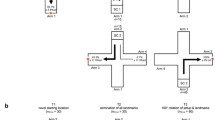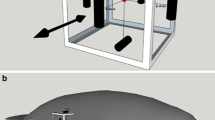Abstract
Absolute and relative volumes of four sensory areas (olfactory bulb, optic tectum, octavolateral area, gustatory area) and two integration centers (telencephalon, cerebellum) were determined in 39 specimens of the demersal grenadier Coryphaenoides armatus from early postmetamorphic stages to adulthood (94–900 mm total length). The relative volume of the optic tectum decreased and the relative volume of the olfactory bulb increased up to a total length of about 500 mm (corresponding to a total weight of about 1 kg) and remained constant subsequently, whereas the relative volumes of the octavolateral and gustatory areas were unchanged during growth. The developmental switch in sensory orientation from vision to olfaction is associated with changes in behavior recorded in lander experiments and feeding strategies based on head morphology and stomach content.


Similar content being viewed by others
References
Armstrong JD, Bagley PM, Priede IG (1992) Photographic and acoustic tracking observations of the behaviour of the grenadier, Coryphaenoides (Nematonurus) armatus, the eel Synaphobranchus bathybius, and other abyssal demersal fish in the North Atlantic Ocean. Mar Biol 112:535–544
Brandstätter R, Kotrschal K (1990) Brain growth patterns in four European cyprinid fish species (Cyprinidae, Teleostei): roach (Rutilus rutilus), bream (Abramis brama), common carp (Cyprinus carpio), and sabre carp (Pelecus cultratus). Brain Behav Evol 35:195–211
Finger TE (1988) Sensorimotor mapping and oropharyngeal reflexes in goldfish, Carassius auratus. Brain Behav Evol 31:17–24
Fröhlich E, Wagner H-J (1998) Development of multibank rod retinae in deep-sea retinae. Vis Neurosci 15:477–483
Geiger W (1956) Quantitative Untersuchungen über das Gehirn der Knochenfische, mit besonderer Berücksichtigung seines relativen Wachstums. Acta Anat 27:324–350
Gitel'zon II, Levin LA (1989) Bioluminescence in oceanology. J Biolumin Chemilumin 4:555–562
Heincke F (1913) Untersuchungen über die Scholle. Generalbericht I. Schollenfischerei and Schollenmessregeln. Vorläufige kurze Übersicht über die wichtigsten Ergebnisse des Berichts. Rapp P-V Reun Cons Perm Int Explor Mer 180:7–8
Henriques C, Priede IG, Bagley PM (2002) Baited camera observations of deep-sea demersal fishes of the northeast Atlantic Ocean at 15–28°N off West Africa. Mar Biol 141:307–314
Herring PJ (2002) The biology of the deep ocean. Oxford University Press, Oxford
Herring PJ, Priede IG, Bagley PM, Way S, Partridge JC (2000) Observations of bioluminescence on the abyssal seafloor. Luminescence 15:211
Huber R, van Staaden MJ, Kaufman LS, Liem KF (1997) Microhabitat use, trophic patterns, and the evolution of brain structure in African cichlids. Brain Behav Evol 50:167–182
Kanwal JS, Caprio J (1987) Central projections of the glossopharyngeal and vagal nerves in the channel catfish, Ictalurus punctatus: clues to differential processing of visceral inputs. J Comp Neurol 264:216–230
Kotrschal K, Palzenberger M (1991) Neuroecology of cyprinids (Cyprinidae, Teleostei): comparative, quantitative histology reveals diverse brain patterns. Environ Biol Fishes 33:135–152
Kotrschal K, Brandstätter R, Gomahr A, Junger H, Palzenberger M, Zaunreiter M (1990) Brain and sensory systems. In: Winfield J, Nelson JS (eds) The biology of cyprinids. Chapman and Hall, London, pp 284–331
Kotrschal K, van Staaden MJ, Huber R (1998) Fish brains: evolution and ecological relationships. J Fish Biol Fish 8:1–36
Lissner H (1923) Das Gehirn der Knochenfische. Wiss Meeresunters Helgol 14:125–184
Marshall NB (1973) Family Macrouridae. In: Cole DM (ed) Fishes of the western North Atlantic. Mem Sear Found Mar Res 1:496–537
McCormick CA (1982) The organization of the octavolateralis area in actinopterygian fishes: a new interpretation. J Morphol 171:159–181
McCormick CA, Bradford MR Jr (1988) Central connections of the octavolateralis system: evolutionary considerations. In: Atema J, Fay RR, Popper AN, Tavolga WN (eds) Sensory biology of aquatic animals. Springer, Berlin Heidelberg New York, pp 733–756
McLellan T (1977) Feeding strategies of the macrourids. Deep-Sea Res 24:1019–1036
Meek J, Nieuwenhuys R (1997) Holosteans and teleosts. In: Nieuwenhuys R, ten Donkelaar HJ, Nicholson C (eds) The central nervous system of vertebrates. Springer, Berlin Heidelberg New York, pp 759–937
Merrett NR (1989) The elusive macrourid alvin and its seeming lack of potential in contributing to intrafamilial systematics. In: Cohen DM (ed) Papers on systematics of gadiform fishes. Contrib Sci (Los Angel) 32:175–185
Merrett NR (1992) Further evidence on abyssal demersal ichthyofaunal distribution in the eastern North Atlantic, with special reference to Coryphaenoides (Nematonurus) armatus (Macrouridae). J Mar Biol Assoc UK 72:5–24
Merrett NR, Haedrich RL (1997) Deep-sea demersal fish and fisheries. Chapman and Hall, London
Merrett NR, Gordon JDM, Stethmann M, Haedrich RL (1991a) Deep demersal fish assemblage structure in the Porcupine Seabight (eastern North Atlantic): slope sampling by three different trawls compared. J Mar Biol Assoc UK 71:329–358
Merrett NR, Haedrich RL, Gordon JDM, Stethmann M (1991b) Deep demersal fish assemblage structure in the Porcupine Seabight (eastern North Atlantic): results of single warp trawling at lower slope to abyssal soundings. J Mar Biol Assoc UK 71:359–373
Morita Y, Finger TE (1985) Reflex connections of the facial and vagal gustatory systems in the brainstem of the bullhead catfish, Ictalurus nebulosus. J Comp Neurol 231:547–558
Nieuwenhuys R, Pouwels E (1983) The brain stem of actinopterygian fishes. In: Northcutt RG, Davis RE (eds) Fish neurobiology. 1. Brain stem and sense organs. University of Michigan Press, Ann Arbor, pp 25–87
Nieuwenhuys R, ten Donkelaar HJ, Nicholson C (1997) The central nervous system of vertebrates. Springer, Berlin Heidelberg New York
Northcutt RG (1983) Evolution of the optic tectum in ray-finned fishes. In: Northcutt RG, Davis RE (eds) Fish neurobiology. 2. Higher brain areas and functions. University of Michigan Press, Ann Arbor, pp 1–42
Northcutt RG (1988) Sensory and other neural traits and the adaptationist program: mackerels of San Marco? In: Atema J, Fay RR, Popper AN, Tavolga WN (eds) Sensory biology of aquatic animals. Springer, Berlin Heidelberg New York, pp 869–883
Popper AN, Fay RR (1993) Sound detection and processing by fish: critical review and major research questions. Brain Behav Evol 41:14–38
Priede IG, Bagley PM (2000) In situ studies on deep-sea demersal fishes using autonomous unmanned lander platforms. Oceanogr Mar Biol Annu Rev 38:357–392
Priede IG, Merrett NR (1996) Communitiy studies, part II. Estimation of abundance of abyssal demersal fishes; a comparison of data from trawls and baited cameras. J Fish Biol 49[Suppl A]:207–216
Priede IG, Smith KL Jr, Armstrong JD (1990) Foraging behavior of abyssal grenadier fish: inferences from acoustic tagging and tracking in the northern Pacific Ocean. Deep-Sea Res 37:81–101
Priede IG, Bagley PM, Smith A, Creasy S, Merrett NR (1994) Scavenging deep demersal fishes of the Porcupine Seabight (NE Atlantic Ocean); observations by baited camarea, trap and trawl. J Mar Biol Assoc UK 74:481–498
Robertson DA (1981) Possible functions of surface structures and size in some planktonic eggs of marine fishes. NZ J Mar Freshw Res 15:147–153
Sedberry GR, Musick JA (1978) Feeding strategies of some demersal fishes of the continental slope and rise off the mid-Atlantic coast of the USA. Mar Biol 44:357–375
Wagner H-J (2001a) Sensory brain areas in mesopelagic fishes. Brain Behav Evol 57:117–133
Wagner H-J (2001b) Brain areas in abyssal demersal fish. Brain Behav Evol 57:301–316
Wagner H-J (2002) Sensory brain areas in three families of deep-sea fish (slickheads, eels and grenadiers): comparison of mesopelagic and demersal species. Mar Biol 141:807–817
Wagner H-J, Mattheus U (2002) Pineal organs in deep demersal fish. Cell Tissue Res 307:115–127
Widder EA (1999) Bioluminescence. In: Archer SN, Djamgoz MBA, Loew ER, Partridge JC, Vallerga S (eds) Adaptive mechanisms in the ecology of vision. Kluwer, Dordrecht, pp 555–581
Widder EA, Berstein SA, Bracher DF, Case JF, Reisenbichler KR, Torres JJ, Robison BH (1989) Bioluminescence in Monterey Submarine Canyon: image analysis of video recordings from a midwater submersible. Mar Biol 100:541–551
Wilson RR Jr, Smith KL Jr (1984) Effect of near-bottom currents on detection of bait by the abyssal grenadier fishes Coryphaenoides ssp., recorded in situ with a video camera free-vehicle. Mar Biol 84:83–91
Acknowledgements
The project was financially supported by the DFG (Wa 348/22-2), and indirectly by the British NERC (GR3/12789) through an invitation to participate in the "Discovery" cruises. I am indebted to M.A. Collins and I.G. Priede (Aberdeen) for organizing and coordinating the work on board ship as PSO, and to the masters and crews of R.R.S. "Discovery" for highly competent nautical work. U. Mattheus and B. Hirt helped with the capture of some fish and the graphics.
Author information
Authors and Affiliations
Corresponding author
Additional information
Communicated by O. Kinne, Oldendorf/Luhe
Rights and permissions
About this article
Cite this article
Wagner, HJ. Volumetric analysis of brain areas indicates a shift in sensory orientation during development in the deep-sea grenadier Coryphaenoides armatus . Marine Biology 142, 791–797 (2003). https://doi.org/10.1007/s00227-002-0990-7
Received:
Accepted:
Published:
Issue Date:
DOI: https://doi.org/10.1007/s00227-002-0990-7




